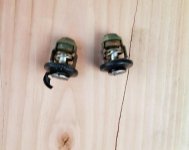I have a 2006 225hp outboard with about 1400 hours. A few days ago, about 30 minutes after starting my trip, the alarm goes off, and the red overheat light lights up. I was going at idle speed. I shut off the engine then restarted it and it was perfect for another 15 minutes. This time I was going about 3,000 rpm and when the alarm and light went on, the engine slowed down. I slowed down and the light and alarm went off by itself after about 5 seconds without me stopping the engine.
I went back to the dock and changed the 02 sensor.. (I had to change that a few times and it was similar symptoms but with the check engine light instead of overheat.) I think it helped... I got about 40 minutes out without a problem and it happened again. I shut it down, restarted and was fine to get home.
The engine is peeing -but this engine's pee stream was always weaker than the other engine.
the water pump was changed about 120 hours ago at the beginning of the season but the thermostat was changed 220 hours ago - start of last season.
Any ideas on cause?
I went back to the dock and changed the 02 sensor.. (I had to change that a few times and it was similar symptoms but with the check engine light instead of overheat.) I think it helped... I got about 40 minutes out without a problem and it happened again. I shut it down, restarted and was fine to get home.
The engine is peeing -but this engine's pee stream was always weaker than the other engine.
the water pump was changed about 120 hours ago at the beginning of the season but the thermostat was changed 220 hours ago - start of last season.
Any ideas on cause?


